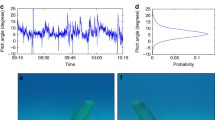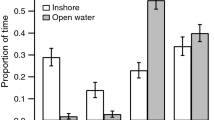Synopsis
The purpose of this study was to determine if body and fin form affected the maneuverability of teleostean fishes as measured by their ability to negotiate simple obstacles. Obstacles were vertical and horizontal rectangular slits of different widths, for which width was defined as the minimum dimension of a slit irrespective of slit orientation. Performance was measured as the smallest slit width traversed. Three species with different body and fin patterns were induced to swim through slits. Species tested were; goldfish Carassius auratus with a fusiform body, anterio-ventral pectoral fins and posterio-ventral pelvic fins; silver dollars Metynnis hypsauchen with the same fin configurations but a gibbose body; angelfish Pterophyllum scalare with a gibbose body and anterio-lateral pectoral fins. Minimum slit widths negotiated were normalized with the length of various body dimensions: total length, maximum width, span at the pectoral fins, and volume1/3 (numerically equal to mass1/3). Goldfish had the poorest performance, requiring the largest slit widths relative to these body dimensions. No consistent patterns in performance were found for silver dollars vs. angelfish. There were no differences among species in the ratio of minimum vertical slit width negotiated to that for horizontal slits, indicating fish were equally able to control posture while swimming on their sides. There were also no consistent patterns in the times taken to transit slits. Although the deep-bodied fish were able to maneuver through smaller slits, the most striking result is the similarity of minimum slit widths traversed in spite of the large variation in body form. Body form and fin plan may be more important for maneuvering and posture control during sub-maximum routine activities.
Similar content being viewed by others
References cited
Alexander, R. McN. 1967. Functional design in fishes. Hutchinson, London. 160 pp.
Beamish, F.W.H. 1978. Swimming capacity. pp. 101–187. In: W.S. Hoar & D.J. Randall (ed.) Fish Physiology, Vol. 7, Locomotion, Academic Press, New York.
Blake, R.W. 1976. On seahorse locomotion. J. Mar. Biol. Ass. UK 56: 939–949.
Blake, R.W. 1977. On ostraciiform locomotion. J. Mar. Biol. Ass. UK 57: 1047–1055.
Blake, R.W. 1978. On balistiform locomotion. J. Mar. Biol. Ass. UK 58: 73–80.
Blake, R.W., L.M. Chatters & P. Domenici. 1995. Turning radius of yellowfin tuna (Thunnus albacores) in unsteady swimming manoeuvres. J. Fish Biol. 46: 536–538.
Blaxter, J.H.S. & L.A. Fuiman. 1990. The role of the sensory systems of herring larvae in evading predatory fishes. J. Mar. Biol. Ass. UK 70: 413–427.
Boisclair, D. 1992. An evaluation of the stereocinematographic method to estimate fish swimming speed. Can. J. Fish. Aquat. Sci. 49: 523–531.
Boisclair, D. & M. Tang. 1993. Empirical analysis of the swimming pattern on the net energetic cost of swimming in fishes. J. Fish Biol. 42: 169–183.
Breder, C.M. 1926. The locomotion of fishes. Zoologica 4: 159–297.
Daniel, T.L. & P.W. Webb. 1987. Physics, design and locomotor performance. pp. 343–369. In: P. Dejours, L. Bolis, C.R. Taylor & E.R. Weibel (ed.) Comparative Physiology: Life in Water and On Land, Liviana Press, Springer-Verlag, New York.
Domenici, P. & R.W. Blake. 1993. Escape trajectories in angelfish (Pterophyllum eimekei). J. Exp. Biol. 177: 253–272.
Eaton, R.C., R. DiDomenico & J. Nissanov. 1988. Flexible body dynamics of the goldfish C-start: implications for reticulospinal command mechanisms. J. Neurosci. 8: 2758–2768.
Ehlinger, T.J. 1990. Habitat choice and phenotype-limited feeding efficiency in bluegill: individual differences and trophic polymorphism. Ecology 71: 886–896.
Ehlinger, T.J. & D.S. Wilson. 1988. Complex foraging polymorphism in bluegill sunfish. Proc. Nat. Acad. Sci. U.S.A. 85: 1878–1882.
Gamperl, A.K. & E.D. Stevens. 1991. Sprint-training effects on trout (Oncorhynchus mykiss) white muscle structure. Can. J. Zool. 69: 2786–2799.
Howland, H.C. 1974. Optimal strategies for predator avoidance: the relative importance of speed and manoeuverability. J. Theor. Biol. 47: 333–350.
Hoerner, S.F. 1965. Fluid-dynamic drag. Hoerner Fluid Dynamics, Brick Town. pp. O-1 to Z-8.
Johnson, D.L., R.A. Beamier & W.E. Lynch. 1988. Selection of habitat structure interstice size by bluegills and largemouth bass in ponds. Trans. Amer. Fish. Soc. 117: 171–179.
Kerr, S.R. 1982. Estimating the energy budgets of actively predatory fishes. Can. J. Fish. Aquat. Sci. 39: 371–379.
Krohn, M.M. & D. Boisclair. 1994. Use of a stereo-video system to estimate the energy expenditure of free-swimming fish. Can. J. Fish. Aquat. Sci. 51: 1119–1127.
Moyle, P.B. & J.J. Cech, 1988. Fishes: an introduction to ichthyology. Prentice Hall, Englewood Cliffs. 559 pp.
Nilsson, G.E., P. Rosén & D. Johansson. 1993. Anoxic depression of spontaneous locomotion activity in crucian carp quantified by a computerized imaging technique. J. Exp. Biol. 180: 153–162.
Norberg, U.M. 1990. Vertebrate flight. Springer-Verlag, New York. 291 pp.
Videler, J.J. 1993. Fish swimming. Chapman and Hall, New York. 260 pp.
Videler, J.J. & D. Weihs. 1982. Energetic advantages of burst-and-coast swimming of a fish at high speeds. J. Exp. Biol. 97: 169–178.
Vogel, S. 1994. Life in moving fluids. Princeton University Press, Princeton. 467 pp.
Ware, D.M. 1975. Growth, metabolism, and optimal swimming speed of a pelagic fish. J. Fish. Res. Board Can. 32: 33–41.
Ware, D.M. 1978. Bioenergetics of pelagic fish: theoretical changes in swimming speed in relation with body size. J. Fish. Res. Board Can. 35: 220–228.
Webb, P.W. 1975. Hydrodynamics and energetics of fish population. Bull. Fish. Res. Board Canada 190: 1–159.
Webb, P.W. 1976. The effect of size on the fast-start performance of rainbow trout (Salmo gairdneri Richardson) and a consideration of piscivorous predator-prey interactions. J. Exp. Biol. 65: 157–177.
Webb, P.W. 1982. Locomotor patterns in the evolution of actinopterygian fishes. Amer. Zool. 22: 329–342.
Webb, P.W. 1983. Speed, acceleration and manoeuverability of two teleost fishes. J. Exp. Biol. 102: 115–122.
Webb, P.W. 1984. Body form, locomotion and foraging in aquatic vertebrates. Amer. Zool. 24: 107–120.
Webb, P.W. 1986. Locomotion and predator-prey relationships. pp. 24–41. In: M.E. Feder & G.V. Lauder (ed.) Predator-Prey Relationships, Chicago University Press, Chicago.
Webb, P.W. 1990. How does benthic living affect body volume, tissue composition, and density of fishes? Can. J. Zool. 68: 1250–1255.
Webb, P.W. 1991. Composition and mechanics of routine swimming of rainbow trout, Oncorhynchus nerka. Can. J. Fish. Aquat. Sci. 48: 583–590.
Webb, P.W. 1992. Is the high cost of body/caudal fin undulatory propulsion due to increased friction drag? J. Exp. Biol. 162: 157–166.
Webb, P.W. 1994a. Exercise performance of fish. pp. 1–49. In: J.H. Jones (ed.) Advances in Veterinary Science and Comparative Medicine 38b, Academic Press, Orlando.
Webb, P.W. 1994b. The biology of fish swimming. pp. 45–62. In: L. Maddock, Q. Bone & J.V. Rayner (ed.) Mechanics and Physiology of Animal Swimming, Cambridge University Press, Cambridge.
Webb, P.W. & R.S. Keyes. 1981. Division of labor between median fins in swimming dolphin fish. Copeia 1981: 901–904.
Weihs, D. 1977. Effects of size on sustained swimming speeds of aquatic organisms. pp. 333–338. In: T.J. Pedley (ed.) Scale Effects in Animal Locomotion, Academic Press, New York.
Weihs, D. 1981. Effect of swimming path curvature on the energetics of fish. U.S. Fish. Bull. 79: 171–176.
Weihs, D. & P.W. Webb. 1983. Optimization of locomotion. pp. 339–371. In: P.W. Webb & D. Weihs (ed.) Fish Biomechanics, Praeger, New York.
Werner, E.E. 1986. Species interactions in freshwater fish communities. pp. 344–357. In: J. Diamond & T.J. Case (ed.) Community Ecology, Harper & Row, New York.
Author information
Authors and Affiliations
Rights and permissions
About this article
Cite this article
Webb, P.W., LaLiberte, G.D. & Schrank, A.J. Does body and fin form affect the maneuverability of fish traversing vertical and horizontal slits?. Environ Biol Fish 46, 7–14 (1996). https://doi.org/10.1007/BF00001692
Received:
Accepted:
Issue Date:
DOI: https://doi.org/10.1007/BF00001692




